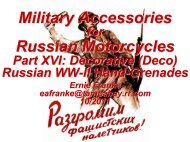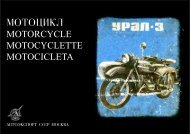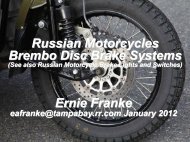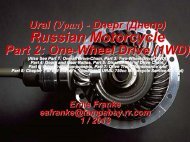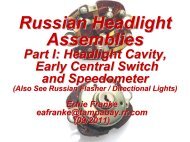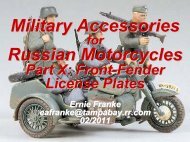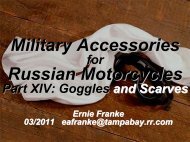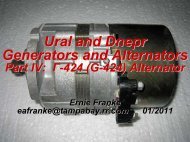Military Accessories Russian Motorcycles - Good Karma Productions
Military Accessories Russian Motorcycles - Good Karma Productions
Military Accessories Russian Motorcycles - Good Karma Productions
Create successful ePaper yourself
Turn your PDF publications into a flip-book with our unique Google optimized e-Paper software.
<strong>Military</strong> <strong>Accessories</strong><br />
for<br />
<strong>Russian</strong> <strong>Motorcycles</strong><br />
Part XI: Radios for <strong>Russian</strong><br />
Sidecar <strong>Motorcycles</strong><br />
(Русские<br />
мотоциклов)<br />
Ernie Franke<br />
eafranke@tampabay.rr.com<br />
03/2011
Adding a Mobile/Portable Radio to a <strong>Russian</strong> Sidecar<br />
• In 1940, the Soviet Union Acquired Blueprints and Casting Molds for BMW's Out-Dated R-<br />
71 <strong>Motorcycles</strong> and Sidecars<br />
• First M-72 Model Finished in 1941<br />
• M-72 Was Sole-Source for <strong>Russian</strong> <strong>Military</strong> <strong>Motorcycles</strong><br />
–During World War-II, 9,799 M-72 <strong>Motorcycles</strong> Delivered for Reconnaissance Detachments<br />
and Mobile Troops<br />
–M-72 Outfits Were Used Against German Invasion of Russia in 1941<br />
–Initially Used in Combat<br />
• Many Functions of WW II <strong>Military</strong> <strong>Motorcycles</strong> Were Replaced by Jeeps<br />
• Later Motorcycle Used Only for Dispatch Riders, Scouts and <strong>Military</strong> Police<br />
• Just Like Demo Machine-Guns, Radios Might Not Be Used for Communication Today<br />
–<strong>Russian</strong> Radios Use FM: Not Available for Citizen Band (CB) Which Uses AM and SSB<br />
–Radios R-107 / R-108 Work on 10-meter Amateur (Ham) Band 28 MHz to 29.7 MHz<br />
• FM Sub-Band: 29.510 MHz to 29.700<br />
• Sub-Band Channelized into Repeater Input/Output and Simplex Frequencies<br />
–Repeater Input Channels: 29.520, 29.540, 29.560, and 29.580 MHz<br />
–Repeater Output Channels: 29.620, 29.640, 29.660, and 29.680 MHz<br />
–Main or Calling Simplex Channel: 29.600 MHz<br />
–Other FM Simplex Channels in Use: 29.5 to 29.7 MHz (98% of the Activity)<br />
–Normal Modulation: 16 kHz Wide Signals with ±5 kHz Peak Deviation<br />
–Legal IF Participants hold a General, Advanced, or Amateur Extra Class License<br />
»Persons Holding Technician or Novice Class License CANNOT Use FM on that<br />
Frequency (47 CFR Part 97 Section 97.307(f)(10))<br />
–FM Legal on All Amateur Frequencies below 29.0 MHz IF Modulation Index Doesn’t<br />
Exceed 1.0 (47 CFR Part 97 Section 97.307(f)(1))<br />
• WW II <strong>Russian</strong> Radio Was in Its Infancy<br />
–Low-Efficiency, High-Consumption Designs<br />
• Electron Tubes (no Transistors until Late 1950’s)<br />
–Radio Development Took Off in Late 1950’s (after WW-II)<br />
Typically folks add radios to complete their WW-II <strong>Russian</strong> bikes,<br />
while folks with a ham license can actually use them.
BMW R-61 R<br />
Motorcycle and Sidecar<br />
The BMW R-61 was used by the Wehrmacht (German Army) between 1938<br />
and 1941, before switching to the R-75. The M-72 (father of all<br />
<strong>Russian</strong> bikes) was a direct descendant of the BMW R-61/71 series.
Early (pre WW-II) vs. Later (post WW-II)<br />
<strong>Russian</strong> Radio Development Follows German and American Leads<br />
• German Influence on <strong>Russian</strong> Portable/Mobile Radios<br />
–HF (High-Frequency) AM (Amplitude-Modulation) Operation<br />
• Tornister.Funkgerät (Torn.Fu.*) HF AM Portable Transceivers<br />
• Stationary Operation (On-the-Halt)<br />
–VHF (Very High Frequency) AM Operation<br />
• Kleinfunksprecher d (KlFuSpr.d) "Dorette“ Transceiver<br />
–VHF (Very High Frequency) FM (Frequency Modulation) Operation<br />
• Mobile Operation (On-the-Move)<br />
• Tornister.Feldfunksprecher (Feld.Fu.*) VHF AM Back-Pack Transceivers<br />
• American Influence on <strong>Russian</strong> Portable/Mobile Radios<br />
–Use of VHF (Very High Frequency)<br />
• Reliable Line-of-Sight Operational Range<br />
• Short Whip Antenna for Portable Use<br />
• Mobile On-the-Move or On-the-Halt Operation<br />
–Edwin Armstrong Invented Frequency Modulation (FM) in 1933<br />
• Low-Noise<br />
• BC-1000 VHF FM Man-Pack Transceiver<br />
• SCR-508 or SCR-528 (BC-603/BC-604) VHF FM Vehicular Transceiver<br />
• America Lend-Lease Act<br />
–Serious Equipment Shortfalls for <strong>Russian</strong> Armed Forces<br />
–Stalin Met with Representatives of Western Allies<br />
–British and Americans Both Stepped In to Keep Russia in the War<br />
–Lend-lease Act of March 11th 1941 Permitted President of U.S. to ‘Sell, Transfer Title To, Exchange,<br />
Lease, Lend, or Otherwise Dispose Of, to Any Such Government Whose Defense the President Deems<br />
Vital to the Defense of the United States‘<br />
–President Roosevelt Approved $1 billion in Lend-lease Aid to Soviet Union in 1941<br />
–First Deliveries of <strong>Military</strong> Aid to Russia Began in November 1941<br />
–34,190 <strong>Motorcycles</strong> delivered to the USSR during WW-II, Nicknamed 'Liberators' in Europe<br />
• 26,670 Harley-Davidson Model 42WLA<br />
• 7,520 Indian Models 741, 340 and 344<br />
• Most of the WLAs Delivered to USSR Were Equipped with M-72 Sidecar<br />
–$11 billion in Materiel Given to Russia Until Lend-Lease Ended in 1945<br />
Just as the M-72 sidecar was a copy of the German BMW R-71,<br />
<strong>Russian</strong> radios owe their heritage to captured German radios from WW-II,<br />
the invention of FM, and to the lend-lease program.
Two Types of WW-II <strong>Russian</strong> Radios<br />
• Two Types of WW II <strong>Russian</strong> Radios<br />
–Seat Mounted: Strapped onto Seat<br />
• Larger Radios<br />
• On-the-Halt Operation<br />
• Examples:<br />
–German Back-Pack Transceiver Torn.Fu.d2<br />
–German KlFuSpr.d “Dorette”<br />
–German Transceiver WR1<br />
–Side Mounted: Bracket Mount on Sidecar<br />
• Smaller Man-Pack Radios<br />
• On-the-Halt and On-the-Move Operation<br />
• Examples:<br />
–German Feld.Fu.b/c/f Backpack Sets<br />
–<strong>Russian</strong> R-104/-105/-106/-108/-109
<strong>Russian</strong> Bikes with a R-105d R<br />
(Д) Mounted on Sidecar<br />
M-72<br />
MB-750<br />
The portable radio may be mounted inside or outside the tub.
German BMW with Radio<br />
<strong>Motorcycles</strong> bearing the<br />
letters WH were used<br />
by the Wehrmacht<br />
Heer<br />
(German Army)<br />
On many German bikes, the radio was secured<br />
on the passenger seat for portable operation.
Radio Direction-Finding from the Sidecar<br />
<strong>Motorcycles</strong> bearing the<br />
letters WH were used<br />
by the Wehrmacht<br />
Heer<br />
(German Army)<br />
The direction-finding equipment was mounted in the boot of the sidecar.
Repro German Field Radio Torn.Fu.d2 (www.worthpoint.com)<br />
•Squad-Level Radio<br />
•Very Common Throughout WW-II<br />
•Complete original Torn.Fu.d2 Radio Is Very Rare<br />
•Many Original Radios Were Destroyed in Battle or by Allies after the War<br />
•Full-Scale Replica of German Torn.Fu.d2<br />
•Proportions of the Box Are Correct, as Copied from Original Box<br />
•Made from Similar Materials as Original Box and is Same Weight<br />
•Faceplate Was Cast from Original Radio<br />
Torn.Fu.d2 on Passenger Seat of Motorcycle<br />
If you have been wanting an accurate radio to complete<br />
your WW-II impression, then this is the radio you want.
Repro German Field Radio Feld.Fu Container,<br />
together with Original (http://home.online.no)<br />
The replica box for the Feld.Fu is excellent for surviving in the field.
WW-II <strong>Russian</strong> Radio Time-Line<br />
German Torn .Fu.b1 Ground<br />
Transceiver<br />
American<br />
SCR-300<br />
BC-1000<br />
U.S. Man-Pack<br />
American<br />
SCR-508 or SCR-528<br />
BC-603/BC-604<br />
U.S. Vehicular<br />
<strong>Russian</strong><br />
R-105d /<br />
R-108d /<br />
R-109d<br />
Family<br />
R-105d R-108d R-109d<br />
R-105m<br />
<strong>Russian</strong><br />
R-105m /<br />
R-108m /<br />
R-109m<br />
Family<br />
1933 1935 1940 1941 1942 1944 1946 1948 1959<br />
1964<br />
Invention of FM<br />
(Frequency<br />
Modulation)<br />
Lend-Lease German<br />
with Russia KlFuSpr.d<br />
Dorette<br />
Captured and Duplicated<br />
German Radios<br />
<strong>Russian</strong> Portable and<br />
Man-Pack Radios<br />
Lend-Lease of American<br />
Radios and <strong>Motorcycles</strong><br />
Development of FM and<br />
American Radios<br />
<strong>Russian</strong> Portable and<br />
Man-Pack Radios<br />
The R-105 was first introduced in the late 1940's<br />
and revamped in the 1960's to use more modern materials.
1920's NYPD Sidecar<br />
During early development of radio, folks were eager to find new methods<br />
of tactical communications. During the 1930's and until 1947,<br />
police agencies used RCA, GE, Motorola, Comco, Air Associates,<br />
Link Radio (Vetric) and a variety of home-made made radios.
Motorcycle Radio Transmitters Aid Police<br />
in War on Crime (Modern Mechanix, Nov. 1933)<br />
The 1930’s s continued to see development of mobile radio<br />
for tactical communications.
CHiP Motorcycle, circa 1938, with RCA Receiver<br />
(www.wb6nvh.com)<br />
Prior to 1946, virtually all commercially-made made police motorcycle<br />
radios were one-way "receive-only" sets.
American Development of Jeep: Man-Pack Radio<br />
• SCR-300: BC-1000 Back-Pack VHF FM Transceiver<br />
–In 1940, Motorola Received Contract to Develop Portable, Battery-Powered FM voice<br />
Transceiver (transmitter / receiver), for Field Use by Infantry Units<br />
• Weight Limit of 35 lbs, To Be Carried on Back of a Soldier<br />
• Waterproof and Be Able to Withstand Tropical Fungus<br />
• Same Frequency Band of VRC-3 (used in tanks) for Intercommunication between<br />
Armor and Infantry<br />
–Frequency Range: 40.0 to 48.0 MHz and Transmitter Output Power: 0.3 Watts FM<br />
–Range of 3 miles with Longer 33" (84 cm) End-Loaded, Whip Antenna<br />
–Almost 50,000 Walkie-Talkies Produced by Motorola during WW-II<br />
• Radio Set SCR-508/SCR-528: BC-603 Receiver and BC-604 Transmitter WW II Jeep Radio<br />
–Very High Frequency (VHF) Two-Way Transceiver (transmitter / receiver)<br />
–Mounted in American Jeeps or Carried as Back-Pack by American GI's<br />
–Communication between Moving or Stationary vehicles or as Portable Field Transceivers<br />
–Shipped from USA as Part of US Lend-Lease program in War against Nazi Germany<br />
–Used in WW-II Armored Fighting Vehicles such as M3, M26, M5 and M4 "Sherman” Tanks<br />
–Operates from 12-Volt Vehicle Battery<br />
–Frequency Range: 20 to 28 MHz and Transmitter Output Power: 30 Watts FM<br />
–Range: 15 miles (Voic) and 30 miles (code) between Moving Vehicles; Much Longer if<br />
Used in Stationary Position with Long Antenna<br />
BC-1000<br />
Backpack Radio<br />
BC-603/BC-604<br />
Vehicular Radio<br />
The R-Series R<br />
<strong>Russian</strong> radios owe part of their heritage<br />
to the development of American radios and to lend-lease<br />
lease.
German WWW-II Portable and Mobile Radios<br />
• German Portable and Mobile Radios Fore-Runners<br />
–Rapid Radio Development of Radio in Germany<br />
• Torn.Fu.* (1937) Proved Rugged and Reliable for Portable Use<br />
–Two Features Needed in USSR<br />
• German tanks were all equipped with radios, allowing them to communicate<br />
with one another throughout battles,<br />
–Rapid development of Sidecar <strong>Motorcycles</strong> in Germany<br />
• BMW Developed R-71 (Fore-Runner of Ural and Dnepr)<br />
• BMW Developed R-75 (Principle German WW-II Sidecar Motorcycle)<br />
–Portable/Mobile Radio Added to <strong>Motorcycles</strong><br />
–Inexpensive Vehicles Developed<br />
• Kubelwagen Developed<br />
–Use of Jeep-Like Vehicles Later Preferred<br />
–Radio Proved Most Valuable for Artillery Spotting<br />
German radio and motorcycle development strongly influenced<br />
the development of mobile communications in the USSR.
German Radio Communication Vehicles<br />
Sd. Kfz. 260 unarmed radio communication<br />
Sd. Kfz. 261’s s main difference from the Sd.<br />
vehicle, used in tank and motorized units<br />
Kfz. 260 was the type of antenna<br />
German Sd. Kfz. 222 was the main light-armored vehicle of<br />
the German Wehrmacht, used in all fronts of WW II<br />
Early German blitzkrieg, with tank and armored formations,<br />
created new requirements for split-second second communication<br />
by radio among all members.
WW-II German Radio Operator Using a Torn.fu.b1 Transceiver<br />
(Transmitter/Receiver) Mounted on Sidecar<br />
German radios, unlike Japanese sets, were extremely well-adapted sets.
German Torn.Fu.* Transceiver on Zundapp (desyatnik.com)<br />
* = model number<br />
Portable operation proved valuable as a rapidly-deployed,<br />
deployed,<br />
front-line observation post.
German Radio (Kfz 2) Kuebelwagen<br />
KFZ stands for Kraftfahrzeug<br />
(common abbreviation for car)<br />
The Volkswagen Kübelwagen K<br />
(short for<br />
Kübelsitzwagen, meaning "bucket"<br />
seat car") was a<br />
military vehicle designed by Ferdinand Porsche and<br />
built by Volkswagen during WW W II<br />
Torn.Fu Radio<br />
Ultimately the Wehrmacht replaced the motorcycle with the<br />
Kuebelwagen, , a Jeep-like<br />
radio-car based on the Volkswagen,<br />
designed to accommodate Torn.Fu transceivers.
German Torn.Fu.* on Kraftfahrzeug 2 (battlefrequencies.com)<br />
In every tank there was at least one radio<br />
and in some command tanks as many as three.
German Trench Operation with the Torn.Fu.<br />
The Torn.Fu. portable transceiver was not intended<br />
to be used while on the move.
German Tornister-Funkger<br />
Funkgerät t (Back-Pack Radio Set)<br />
Torn.Fu.b1<br />
Portable Transceiver<br />
• Developed as a Mobile Transceiver<br />
• Robust, Small Enough to Be Carried by Infantry<br />
• Easily Installed into Vehicles<br />
• Introduced by Lorenz Company in 1935<br />
• Antenna Assembly Mounts Directly onto Top Using Screwed Collar<br />
• Frequency Range<br />
–Receiver (Left Empfänger): 3 to 6.7 MHz<br />
–Transmitter (Right Sender): 3 to 5 MHz<br />
• Power Source: One Filament Battery (2.4 MC38) and Two 90-Volt Anode Batteries<br />
• External Power Supply: 12-Volt / 4.5 Amp<br />
• Size and Weight:<br />
–Carried by Two Men: Hooks on Reverse Side for Infantry Carrying-Straps<br />
–Transceiver (Transmitter/Receiver) Unit: 13-1/2 x 17 x 8 inch / 38 lbs<br />
–Other Chest: Battery Pack, Headphones, Key, Microphone, Antenna Assembly<br />
and Other <strong>Accessories</strong>: 13-1/2 x 17 x 8 inch / 35 lbs<br />
In the 1920’s and 1930’s, when the blitzkreig tactics were being<br />
developed, inter-vehicle communication was necessary,<br />
utilizing an array of available frequency bands.
German Tornister-Funkger<br />
Funkgerät t (Back-Pack Radio Set)<br />
Torn.Fu.d2<br />
Portable Transceiver<br />
• Produced in 1936 with Latest Electron Tube Technology Available<br />
• VHF 2-Way Communications Device<br />
• Frequency Range: 33.8 to 38.0 MHz<br />
• AM Modulation: A1 (Code) and A3 (Voice)<br />
• Communication Range: Approx. 10 km (A1) / 3 km (A3)<br />
• Can Be Operated from Field Telephone via 1-to-2 km Field Line<br />
• Transmitter Output Power: 1 Watt<br />
• Size / Wt: 0.39 X 0.34 X 0.19 m / 17 kg<br />
All German tanks were equipped with Tornister E.b<br />
radio receivers, and many had transmitters as well.
German Tornister-Funkger<br />
Funkgerät t Torn.Fu.g Portable Transceiver<br />
• Carried (dismounted) in Steel Container with Carrying Straps<br />
• Transceiver Container Has Operating Side with Remote Control Unit<br />
• Used for Battalion-to-Company, Company-to-Platoon and -Lower Echelons<br />
• Frequency Range: 2.5-3.5 MHz.<br />
• Antenna<br />
–Antenna Socket on Top<br />
–Sectional Rod with Umbrella (stationary); Whip Antenna When On-the-Move<br />
• Power Source: One 2.4-Volt Storage Battery and Built-in Vibrator Unit<br />
• Battery Capacity: 15 hrs (33% transmit / 67% receive)<br />
• Similar to American SCR-194, SCR-195 and SCR-300<br />
• Used in Stationary Positions or On-the-Move<br />
• Modulation: A1 (Code) and A3 (Voice)<br />
The Torn.Fu.g<br />
The Torn.Fu.g was mainly used by Panzer Grenadiers to communicate<br />
with command vehicles. Panzer Grenadiers were infantry troops<br />
assigned to protect tanks in battle, as tanks by themselves<br />
are vulnerable to infantry with anti-tank weapons.
German Tornister-Funkger<br />
Funkgerät t Torn.Fu.h Portable Transceiver<br />
• Transmitter Output Power: 0.06 Watt<br />
• Frequency Range: 23-25 MHz<br />
• Modulation: A3 (Voice)<br />
• Antenna: Whip Antenna Socket on Top<br />
• Power Source: One 2.4-Volt Battery (2.4NC28)<br />
The Torn.Fu.h, like the<br />
The Torn.Fu.h, like the Torn.Fu.d2, operated at VHF<br />
to yield line-f-sight service.
German Tornister-Funkger<br />
Funkgerät t Torn.Fu.i Portable Transceiver<br />
• Introduced by Lorenz Company in 1944<br />
• Transmitter Output Power: 3 Watt<br />
• AM Modulation: A1 (Code) and A3 (Voice)<br />
• Two Types of Antenna<br />
–Antenna-Tuning Spool and Simplified Base<br />
–Whip Antenna, similar to Feld.fu.b1<br />
• Frequency Range: 1.8 to 3.0 MHz<br />
• Power Source: Two 2.4NC58 Batteries or Manual Generator<br />
The Torn.Fu.i<br />
The Torn.Fu.i was a more compact and powerful replacement<br />
for the Torn.Fu.b1, Torn.Fu.f and Torn.Fu.k.
German Tornister-Funkger<br />
Funkgerät t Torn.Fu.k Portable Transceiver<br />
• Introduced in 1943<br />
• Frequency Range<br />
–Transmitter: 4.5 to 6.7 MHz (same as Torn.Fu.f)<br />
–Receiver: 3 to 6.7 MHz (same as Torn.Fu.c)<br />
• Antenna: Wire or Rod<br />
–Low-Rod Antenna<br />
–High-Rod Antenna for Longer Range<br />
–45 foot wire from set to tree can also be used<br />
–Can Be Operated with American 15 ft Vehicular Antenna<br />
• Sensitivity: 100 µV for 1 mV Audio Output<br />
• Transmitter Output Power: Approx. 0.7 Watts<br />
• Use:<br />
–Portable Radio Sets Intended for Field Service as Pack-Sets<br />
–Could Be Operated Remotely Using Ordinary Field Telephone Lines<br />
–Not Used While On-the-Move<br />
• AM Modulation: A1 (Code) and A3 (Voice)<br />
• Range: 12 miles (CW), 6 miles (Voice) with Long-Wire Antenna<br />
• Operating Time: 33 hrs with One Set of Batteries (20% transmit / 80% receive)<br />
• Power Source: Two Filament Batteries (2 X 2.4NC58) and Vibrating Power Supply<br />
• Size: 0.7 x 0.36 x 0.215 m (18.5 x 14.3 x 8.5”)<br />
German radios were similar to the American SCR-511. <strong>Russian</strong> radios<br />
were similar to both American and German transceivers.
German KlFuSpr.d Dorette (www.laud.no<br />
www.laud.no and www.armyradio.com)<br />
• Kleinfunksprecher d (KlFuSpr.d) a.k.a. "Dorette“<br />
• Lightweight Two-Way Radio Transceiver Used by Infantry and Artillery Observations Posts<br />
–Smallest Set Germans Fielded<br />
–Designed for Artillery Forward-Observers<br />
–Last Transceiver Designed in Third Reich<br />
–Ready for Use at End of WW II: Oct. 1944, Seven Months before End of War<br />
• Frequency Range: 33.8 to 38 MHz<br />
• Transmitter Output Power: Approx. 0.2 Watt<br />
• Antenna: 1.6 meter Band Antenna<br />
• Size / Weight<br />
–Transceiver: 0.13 x 0.7 x 0.20 m / 1.6 kg<br />
–Battery/Accessory Box: 0.11 x 0.10 x 0.17 m / 1.5 kg<br />
• Operational Use:<br />
–Base Station with Long-Wire Antenna (Stationary): Point-to-point traffic, Net Operations<br />
–On-the-Move with Whip: Radio Worn on Belt in Front and Battery Box Worn in the Rear<br />
• AM Modulation: A1 (Code) and A3 (Voice)<br />
• RANGE:<br />
–Between Two Dorettes or Between one Dorette and one Torn. Fu. D2: 2-4 km.<br />
–Between Dorette and Feld.fu.f: 1-2 km<br />
• Power Source: 1.4-Volt Filament Battery (LS1.4bp) and 150-Volt Anode Battery (LS150bp)<br />
• Operating Time: 25 hrs with One Battery (20% transmit / 80% receive)<br />
The German KlFuSpr.d “Dorette” served as the inspiration<br />
for several post-war <strong>Russian</strong> Radios.
Tornister.Funkgerät t (Torn.Fu.*) German Portable VHF AM Transceivers<br />
Torn.Fu.*<br />
Torn.Fu.a<br />
Torn.Fu.b1<br />
Torn.Fu.c<br />
Torn.Fu.d2<br />
Torn.Fu.f<br />
Torn.Fu.g<br />
Torn.Fu.h<br />
Torn.Fu.k<br />
Torn.Fu.i<br />
Torn.Fu.t<br />
FuSpr.d<br />
Use<br />
Infantry<br />
Forward<br />
Artillery<br />
Observer<br />
Infantry<br />
Infantry<br />
Panzer<br />
Grenadiers<br />
Artillery<br />
Infantry,<br />
Forward<br />
Artillery<br />
Observer<br />
Frequency<br />
Range<br />
3.0–6.7<br />
MHz<br />
3.0–6.7<br />
MHz<br />
1.5–2.6<br />
MHz<br />
34-38<br />
MHz<br />
3.0–6.7<br />
MHz<br />
2.5-3.5<br />
MHz<br />
23-25<br />
MHz<br />
3.0-6.7<br />
MHz<br />
1.87-3.0<br />
MHz<br />
2.5-3.0<br />
MHz<br />
32-38<br />
MHz<br />
Year<br />
1935/36<br />
1936<br />
1937 - 1945<br />
1935/36<br />
1942<br />
1942<br />
1943<br />
1944<br />
1945<br />
1944<br />
TX Power<br />
2 Watt<br />
0.6-0.8 Watt<br />
0.6 Watt<br />
0.6-1.0 Watt<br />
0.6 Watt<br />
0.5 Watt<br />
0.1 Watt<br />
1.5 Watts<br />
3.0 Watts<br />
0.5 Watt<br />
0.2 Watt<br />
AM<br />
Sensitivity<br />
100 uV<br />
input for 1<br />
mV Audio<br />
100 uV input<br />
for 1 mV<br />
Audio<br />
100 uV<br />
input for 1<br />
mV Audio<br />
100 uV<br />
input for 1<br />
mV Audio<br />
100 uV input<br />
for 1 mV<br />
Audio<br />
100 uV<br />
input for 1<br />
mV Audio<br />
100 uV<br />
input for 1<br />
mV Audio<br />
100 uV<br />
input for 1<br />
mV Audio<br />
Modulation<br />
A1 (Code)<br />
A3 (Voice)<br />
A1 (Code)<br />
A3 (Voice)<br />
A1 (Code)<br />
A3 (Voice)<br />
A1 (Code)<br />
A3 (Voice)<br />
A1 (Code)<br />
A3 (Voice)<br />
A1 (Code)<br />
A3 (Voice)<br />
Antenna<br />
1.American<br />
15 ft<br />
vehicular<br />
ant.<br />
2. Long<br />
Wire<br />
1.5 m Whip,<br />
with<br />
adjustable<br />
coil in the<br />
base, with<br />
freq marks<br />
1.5 m Whip,<br />
with<br />
adjustable<br />
coil in the<br />
base, with<br />
freq marks<br />
1.6-m Band<br />
ant.<br />
Approx.<br />
Range<br />
12 miles<br />
(CW), 6<br />
miles<br />
(Voice)<br />
10-km (A1)<br />
3-km (A3)<br />
9-25 km<br />
12 miles<br />
(A1)<br />
6 miles (A3)<br />
Operate<br />
Time<br />
15 hrs with<br />
one set of<br />
batteries<br />
@33% TX-<br />
67% RX<br />
33 hrs with<br />
one set of<br />
batteries<br />
@20% TX,<br />
80% RX<br />
25 hrs with<br />
one set of<br />
batteries<br />
@20% TX,<br />
80% RX<br />
Size<br />
Radio: 13-<br />
1/2” X 17“<br />
X 8”<br />
Battery<br />
Box: 1/2” X<br />
17“ X 8”<br />
Radio: 0.46 X<br />
0.4 X 0.2 m<br />
Battery Box:<br />
0.46 X 0.4 X<br />
0.2 m<br />
0.39 X 0.34<br />
X 0.19 m<br />
(15.4 X 13.4<br />
X 7.5”)<br />
0.7 x 0.36 x<br />
0.215 m<br />
(18.5 x 14.3<br />
x8.5”)<br />
Radio: 0.13 X<br />
0.7 X 2.0 m<br />
Battery Box:<br />
0.11 X 1.0 X<br />
1.7 m<br />
Weight<br />
Radio: 38<br />
lbs<br />
Battery<br />
Box: 35 lbs<br />
17 kg<br />
(37 lbs)<br />
23 kg<br />
Radio: 1.6 kg<br />
Battery Box:<br />
1.5-kg<br />
Complete radio sets in armored vehicles are referred<br />
to by the designation Fu, with the exception of the FuSpr.f.
Tornister Empfanger (Receiver) Torn.E.b<br />
Torn.E.b (www.laud.no<br />
and www.gdrecon.co.uk)<br />
•Designed around 1935/36<br />
•Lightweight Mobile Use with German Signal Corps<br />
•Used in vehicles<br />
•Light Enough for Infantry to Carry in Back-Pack<br />
•Tuned radio Frequency (TRF) Receiver and Regenerative Detector<br />
•Frequency Range from 0.097 to 7.095 MHz:<br />
•Band l --- 97-175kHz<br />
•Band 2 ---172-310kHz<br />
•Band 3 --- 306-552kHz<br />
•Band 4 --- 541-977kHz<br />
•Band 5 --- 958-1720 kHz<br />
•Band 6 --- 1685-3030 kHz<br />
•Band 7 --- 2940-4760 kHz<br />
•Band 8 --- 4420-7095 kHz<br />
•Modulation: A1 (Morse Code) and A3 (Voice)<br />
•Power Requirement: 2V, 0.8A and 90V, 10mA (HT)<br />
All German tanks were equipped with Tornister E.b<br />
radio receivers, and many had transmitters as well.
German Transceiver WR1 (www.gdrecon.co.uk and www.worthpoint.com)<br />
• Developed in 1940 by Blaupunkt Company<br />
• In 1941, Other German Companies, such as Philips, and Telefunken, Were Contracted to<br />
Manufacture More of These Highly-Successful Transceivers<br />
• In 1941, Improvements in Bandwidth Ranges and More Versatility in the Ranges of Power<br />
Supply Became Known as the WR1/P<br />
• Operating frequencies for the improved WR1/P are in 3 bandwidths; 0.150 to 0.425MHz;<br />
0.517 to 1.54 MHz; and 5.9 to 15.5 MHz.<br />
• Power Supply Model P Was 90-Volt Anode Battery; 2xEML 1.25-Volt Batteries; 4NC58<br />
• Designed to Be Carried by Infantry/Mobile Units<br />
The German transceiver WR1 was developed in preparation for WW-II<br />
II.
Feld.Fu.b/c/f Backpack Sets<br />
• Portable Transceiver Unit<br />
• Short-Range Tactical radio for man pack, or in vehicular mobile use<br />
• self-contained, light weight, backpack radio designed to attach directly to the Y-Straps<br />
• Came into Service about 1940/41<br />
• operated while stationary or on the move.<br />
• Range: Approx. 1-3 km<br />
• Transmitter Output Power: a1 and f: 0.12-0.150 Watts, b and c: 1.2 Watts<br />
• Receiver Sensitivity: 2 uV for 8 dB Quieting<br />
• Frequency Range:<br />
–Feld.Fu.b: 90 - 110 MHz<br />
–Feld.Fu.c: 130 - 160 MHz<br />
–Feld.Fu.f: 32 - 38.0 MHz<br />
• Modulation: A1 (Morse Code) and A3 (Voice)<br />
• Range: 3/4 mile (Voice)<br />
• Antenna Type: 28.5 inches Flexible whip<br />
• Power Source: 2.4 battery (Nickel Cadmium)<br />
Feld.fu. b set (left), complete with flex<br />
antenna and battery charger (right)<br />
The b and c models operate at over 100 MHz putting them outside the operating<br />
frequencies of all other German tactical radios. This meant that they<br />
could only be used within infantry formations. Panzer Grenadiers (armored<br />
reconnaissance units) were issued the f model which operated between 32 and<br />
38 MHz, the same frequency range most commonly found in armored vehicles.
Tornister.Feldfunksprecher (Feld.Fu.*) German VHF AM Back-Pack Radios<br />
(Knapsack Field Radio)<br />
Feld.Fu.*<br />
Use<br />
Frequency<br />
Range<br />
Year<br />
Developed<br />
TX Power<br />
Operate Time<br />
Feld.Fu.a<br />
Infantry,<br />
Reserve Army<br />
120-156 MHz<br />
0.15 Watt<br />
Feld.Fu.b<br />
Infantry, Panzer<br />
Grenadiers<br />
90-110 MHz<br />
1941<br />
0.15 Watt<br />
Feld.Fu.c<br />
Infantry,<br />
Reserve Army<br />
130-160 MHz<br />
0.15 Watt<br />
Feld.Fu.d<br />
Infantry<br />
32-38 MHz<br />
0.15 Watt<br />
Feld.Fu.f<br />
Panzer<br />
Grenadiers<br />
28-33 MHz<br />
0.15 Watt<br />
Feld.Fu.h<br />
23.1-25.0 MHz<br />
0.15 Watt<br />
Amplitude<br />
Modulation<br />
Antenna<br />
A1 (Code),<br />
A3 (Voice)<br />
Whip Ant. basecolor<br />
dark<br />
brown steelblade:<br />
55 cm<br />
A1 (Code),<br />
A3 (Voice)<br />
Whip Ant. basecolor<br />
dark<br />
red steelblade:<br />
75 cm<br />
A1 (Code),<br />
A3 (Voice)<br />
Whip Ant. basecolor<br />
dark<br />
green steelblade:<br />
52 cm<br />
A1 (Code),<br />
A3 (Voice)<br />
Whip Ant. basecolor<br />
white<br />
steel-blade with<br />
base coil: 1.5 m<br />
Whip Ant. basecolor<br />
dark blue<br />
with base coil:<br />
1.5 m<br />
Approx.<br />
Range<br />
A3: ¾ mi<br />
A3: ½ to 1 mi<br />
A3: ½ to 1 mi<br />
A3: ¾ mi<br />
A3: ¾ mi<br />
Size/Wt<br />
German radio technology in the pre-war and early war-time period<br />
was a full 20 years ahead of all other countries in many cases.
<strong>Russian</strong> <strong>Military</strong> Transceiver R-105d<br />
*002.426*<br />
(www.oldtimergarage.eu)<br />
R-105d<br />
(www.oldtimergarage.eu)<br />
The R-105 series was used by <strong>Russian</strong> and East German armies<br />
to provide radio communication within the Division at all levels<br />
down to Company HQ, Infantry and Artillery.
R-105d/108d/109d Family of Man-Pack Transceivers<br />
(www.armyradio.com<br />
and www.greenradio.de)<br />
• Manufactured in Early 50's<br />
• Portable or Mobile Transceiver<br />
–Can Be Operated by Remote Control and Used in Relay Operation<br />
• RF Power Output : Approx. 1.2 Watts<br />
• Modulation: F3 (FM) simplex<br />
• Co-operates with R-107, R-111, R-113, R-123.<br />
• Frequency Ranges in one continuous band :<br />
–R-105d: 36.0 - 46.1 MHz (Channels: 203)<br />
–R-108d: 28.0 - 36.5 MHz (Channels: 171)<br />
–R-109d: 21.5 - 28.5 MHz (Channels: 141)<br />
• Size and Weight:<br />
–Radio: 0.365 x 0.23 x 0.385 m; 21 kg<br />
–Wooden Box: 0.615 x 0.34 x 0.460 m; 40 kg<br />
• Sensitivity: 1.5 µV for 10 dB Quieting<br />
• Antennas:<br />
–Whip 1.5 meter (using counterweight of 3 rays)<br />
–on-board antenna consisting of a combined whip antennas, special bracket with shock absorber<br />
mounting antennas on board vehicles and connecting wire with the length of 1 m-to work on the car<br />
–combined antenna consisting of a whip antenna and 6 tribes (the total height of the antenna 2.7 m),<br />
using counterweight of 5 rays-to work in the parking lot;<br />
–Directional Beam Antenna 40 meters long, hanging at a height of 1 m above the ground-work for<br />
increased range and from shelters;<br />
–Long wire antenna (Beverage Traveling Wave), 40 m, 6 timber columns, 4 herrings with anchoring wire<br />
(higher antenna consisting of beam antennas with 40 m raised at a radio station to a height of 5-6 m,<br />
with gradually declining the opposite end to correspondent-for increased range and from shelters)<br />
–Kulikov antenna, 4 flagpole antenna-parts for 2.7-m-rod antenna, 1 counterpoise<br />
• Power Source: 2 Sets of 2NKN24 Rechargeable batteries (2NKN-24 or 2KN-32)<br />
In a similar fashion to U.S. allocations in the 50's and early 60's, the<br />
VHF frequency spectrum was sectioned-off for different types<br />
of combat units having their own frequency range;<br />
the R-108d being operated by artillery units on 28-36.5 MHz and<br />
the R-109d by anti-aircraft artillery on 21.5-28.5 MHz.
R-105m/108m/109m Family of Man-Pack Transceivers<br />
(www.armyradio.com<br />
and www.greenradio.de)<br />
• Most Common <strong>Russian</strong> Radios Found Around the World<br />
• Developed in the 1960s<br />
• Used in Large Quantities in Warsaw Pack Countries primarily by Infantry for Company to Battalion<br />
Communication<br />
• Replaced the R-105d/108d/109d Family of Transceivers with Similar Technical Specifications<br />
• Frequency Range:<br />
–R-105m: 36 - 46.1MHz<br />
–R-108m: 28 - 38.5MHz (artillery units)<br />
–R-109m: 21.5 - 28.5MHz (anti-aircraft artillery)<br />
• Transmitter Output Power: Approx. 1 Watt<br />
• Modulation: F3 (FM) Simplex<br />
• Can Be Operated Remotely and Used as Radio Relay Operation<br />
• Sensitivity: 2 µV for 20 dB Quieting<br />
• Power Source: Two sets of 2NKN24 2.4 NiCad batteries<br />
• Replaced by R-107 Series<br />
• Antennas:<br />
–Short "Kulikov" Antenna (constructed of a series of aluminum beads strung on a steel cable, a stiff<br />
spring on the end keeps pressure against these beads and a semi rigid but flexible antenna results.<br />
Releasing this spring tension collapses the antenna allowing it to be rolled up for easy storage and<br />
the radio will receive with the antenna collapsed)<br />
–Long Wire Antenna (Beverage), 40 m, 6 timber columns, 4 herrings with anchoring wire<br />
• The M-series is built in two variants:<br />
–Meter in Center<br />
–Meter in the Upper Left Corner<br />
• Size and Weight<br />
–Radio: 0.31 x 0.17 x 0.325 m; 14 kg<br />
–Wooden Box: 0.62 x 0.35 x 0.42 m; 40 kg<br />
The R-105m/108m/109m R<br />
family of man-pack transceivers<br />
has been referred to by many as a slightly updated copy of<br />
captured WW-II German sets and many of it's characteristics,<br />
and accessories will show this lineage.
<strong>Russian</strong> VHF FM Man-Pack Transceiver R-107<br />
Family<br />
• Replaced R-105m/108m/109m Family of Man-Pack Transceivers (Transmitter/Receiver)<br />
–Thus Covers Frequency Range of These Three Models<br />
–Frequency Range: 20-52 MHz in Two Bands:<br />
• Range 1: 20... 36 MHz<br />
• Range 2: 36... 52 MHz<br />
–both continuous tune and pre-set capability, with up to four pre-set frequencies<br />
• Usage: Portable or Mobile Backpack<br />
–Designed for communications up to company level<br />
–can be operated by remote control by using standard field telephones<br />
–Can be operated as a radio relay station , co-operates with R-111, R-113, R-114d, R-105d to R-109d<br />
and R-105m to R-109m<br />
• RF Output: 1 Watt<br />
• Sensitivity: 1.5 µV for 20 dB Quieting<br />
• Modulation: F3 (FM), simplex<br />
• Channel Spacing: 25kHz (1,231 Channels)<br />
• Range: 6 km (3.75 miles) with Whip Antenna, 6-8 km (3.75 - 5 miles) with Combined Rod and 12 - 25 km<br />
(9.4 to 15.6 miles) with Traveling Wave (Beverage) Antenna<br />
• Power: Two Rechargeable KNP-20 (HKN-20) 2.4V NiCad batteries<br />
• Size and Weights:<br />
–Radio: 0.375 x 0.185 x 0.27 m; 16.9 kg.<br />
–Wooden Box: 0.615 x 0.34 x 0.46 m; 45 kg<br />
• Antennas:<br />
–Kulikow Antenna<br />
–2.7-m rod Antenna (6 parts)<br />
–Long Wire Antenna (Beverage): 40 m with 6 timber columns and Anchoring Wire<br />
Later versions of the R-107 family were fully transistorized (t)<br />
with digital frequency readout.
<strong>Russian</strong> VHF FM Transceiver R-107mR<br />
(wftw.nl and www.greenradio.de)<br />
• Nothing in Common with Former R-107 Sets<br />
• Fully Transistorized: Solid-State Circuitry with Unique Digital Display<br />
• Usage: Backpack, Used by Civil Defense and Special Forces<br />
• Frequency Range: 20 - 52 MHz<br />
• Modulation: F3 (FM), simplex and MCW (Modulated Morse Code)<br />
• Transmitter Output Power: 1 and 5 Watt<br />
• Powered by 3 sets of 2.4V NiCad batteries 2KNP20 or 12-Volt<br />
Fully Automatic Antenna Tuning<br />
• Frequency Display<br />
–Unique Digital Readout Using Small Bulbs<br />
–Round Window Fitted on Right-Hand Side of Front Panel<br />
–Digital Frequency Readout of kHz Digits<br />
–Mechanical Selection of MHz Digits<br />
The <strong>Russian</strong> VHF FM Transceiver R-107m was fully transistorized.
<strong>Russian</strong> VHF FM Transceiver R-107tR<br />
107t (wftw.nl and www.greenradio.de)<br />
• Resembles and Uses Basic Structure of R-107-Series<br />
–Uses Transistors / IC’s<br />
–Mechanical Tuning Replaced by Digital LED -Type Operating Frequency Display<br />
• Usage: Back-Pack, Portable and Mobile<br />
• Can Be Operated Remote Control or Used as Relay Operation<br />
• Frequency range 20-52MHz in two ranges<br />
–Range 1: 20 to 36 MHz<br />
–Range 2: 36 to 52 MHz<br />
• Transmitter Output Power: 1 Watt<br />
• Modulation: F3 (FM) Simplex<br />
• Channel spacing: 25kHz<br />
• Powered by two sets of 2.4V NiCad batteries (HKN-20)<br />
• Co-operates with R-111, R-113, R-114d, R-105 D to R-109 D and R-105 to R-109m.<br />
• Size and Weight<br />
–Radio: 0.375 x 0.185 x 0.27 m; 17 kg<br />
–Wooden Box: 0.615 x 0.34 x 0.46 m; 45 kg<br />
• Sensitivity: 1.5 µV for 20 dB Quieting<br />
• Antennas:<br />
–Kulikow Antenna<br />
–2.7-m Rod Antenna<br />
–Long Wire Antenna (Beverage), 40 m<br />
The R-107t is operationally and functionally similar<br />
to the other sets in the R-107 family.
<strong>Russian</strong> WW-II VHF FM Transceivers (Transmitter/Receiver)<br />
Radio<br />
Use<br />
Year<br />
Frequency<br />
(MHz)<br />
TX Power<br />
(Watts)<br />
Sensitivity<br />
Peak Deviation<br />
RX Bandwidth<br />
Channel Step<br />
Operate<br />
Antenna<br />
Current<br />
Consumption<br />
Size<br />
Weight<br />
Range<br />
R-105d<br />
1946-1950<br />
36.0-46.1<br />
1.2 Watt<br />
1.5 µV<br />
for 10 dB<br />
Quieting<br />
±8 kHz<br />
±15 kHz<br />
12 hrs<br />
@TX 20%<br />
TX: 3-A<br />
RX: 1.6-A<br />
21 kg<br />
R-105e<br />
1957<br />
36.0-46.1<br />
not less<br />
than 1<br />
Watt<br />
1.2 µV<br />
for 10 dB<br />
Quieting<br />
±7 kHz<br />
50 kHz<br />
R-105m<br />
Infantry,<br />
Artillery<br />
1964-84<br />
36.0-46.5<br />
1.2 Watts<br />
2 µV<br />
for 10 dB<br />
Quieting<br />
Radio: 0.31 X<br />
1.7 X 0.325 m<br />
Box: 0.62 X<br />
0.35 X 0.42 m<br />
Radio: 14 kg<br />
(31 lbs)<br />
Box: 40 kg<br />
(88 lbs)<br />
R-107<br />
1965<br />
20-52 in two<br />
Bands<br />
1 Watt<br />
1 µV<br />
for 20 dB<br />
Quieting<br />
±76 kHz<br />
25 kHz<br />
12 hrs<br />
@TX 5%<br />
1. Std Kulikow<br />
2. 2.7m Rod<br />
3. Traveling<br />
Wave<br />
(Beverage<br />
40m<br />
doublet)<br />
Radio: 0.375 X<br />
1.85 X 0.27 m<br />
Box: 0.615 X<br />
0.34 X 0.46 m<br />
17 kg (37 lbs)<br />
3.75 mi with<br />
Whip, 4-5 mi<br />
Combined<br />
Rod, 10-15 mi<br />
Traveling<br />
Wave<br />
R-107m<br />
20-52 in two<br />
Bands<br />
1 Watt<br />
1 µV<br />
for 20 dB<br />
Quieting<br />
±6 kHz<br />
25 kHz<br />
12 hrs<br />
@TX 5%<br />
1. Std<br />
Kulikow<br />
2. 2.7m Rod<br />
3. Traveling<br />
Wave<br />
(Beverage<br />
40m<br />
doublet)<br />
Radio: 0.375<br />
X 1.85 X 0.27<br />
m<br />
17 kg (37 lbs)<br />
3.75 mi with<br />
Whip, 4-5 mi<br />
Combined<br />
Rod, 10-15<br />
mi Traveling<br />
Wave<br />
R-107t<br />
20-52 in two<br />
Bands<br />
1 Watt<br />
1.5 µV<br />
for 20 dB<br />
Quieting<br />
±6 kHz<br />
25 kHz<br />
12 hrs<br />
@TX 5%<br />
1. Std Kulikow<br />
2. 2.7m Rod<br />
3. Traveling<br />
Wave<br />
(Beverage<br />
40m<br />
doublet)<br />
Radio: 0.375 X<br />
1.85 X 0.27 m<br />
17 kg (37 lbs)<br />
3.75 mi with<br />
Whip, 4-5 mi<br />
Combined<br />
Rod, 10-15 mi<br />
Traveling<br />
Wave<br />
R-108d<br />
Infantry,<br />
Artillery<br />
1948<br />
28.0-36.5<br />
1.2 Watt<br />
1.2 µV<br />
for 10 dB<br />
Quieting<br />
±6 kHz<br />
±15 kHz<br />
TX: 3-A<br />
RX: 1.6-A<br />
R-108m<br />
Artillery<br />
1964-84<br />
28-36.5<br />
1.2 Watts<br />
2 µV<br />
for 10 dB<br />
Quieting<br />
Radio: 0.31 X<br />
1.7 X 0.325 m<br />
Box: 0.62 X<br />
0.35 X 0.42 m<br />
Radio: 14 kg<br />
(31 lbs)<br />
Box: 40 kg<br />
(88 lbs)<br />
R-109d<br />
1959-66<br />
21.5-28.5<br />
1.2 Watt<br />
1.2 µV<br />
for 10 dB<br />
Quieting<br />
±5 kHz<br />
±12 kHz<br />
TX: 3-A<br />
RX: 1.6-A<br />
Early <strong>Russian</strong> radios for vehicles operated in the VHF<br />
(Very High Frequency) FM (Frequency Modulation) band,<br />
and are very similar to German Torn.Eb units.<br />
R-109m<br />
Air Defense<br />
1964-84<br />
21.5-28.5<br />
1.2 Watts<br />
2 µV<br />
for 10 dB<br />
Quieting<br />
Radio: 0.31 X<br />
1.7 X 0.325 m<br />
Box: 0.62 X<br />
0.35 X 0.42 m<br />
Radio: 14 kg<br />
(31 lbs)<br />
Box: 40 kg<br />
(88 lbs)



